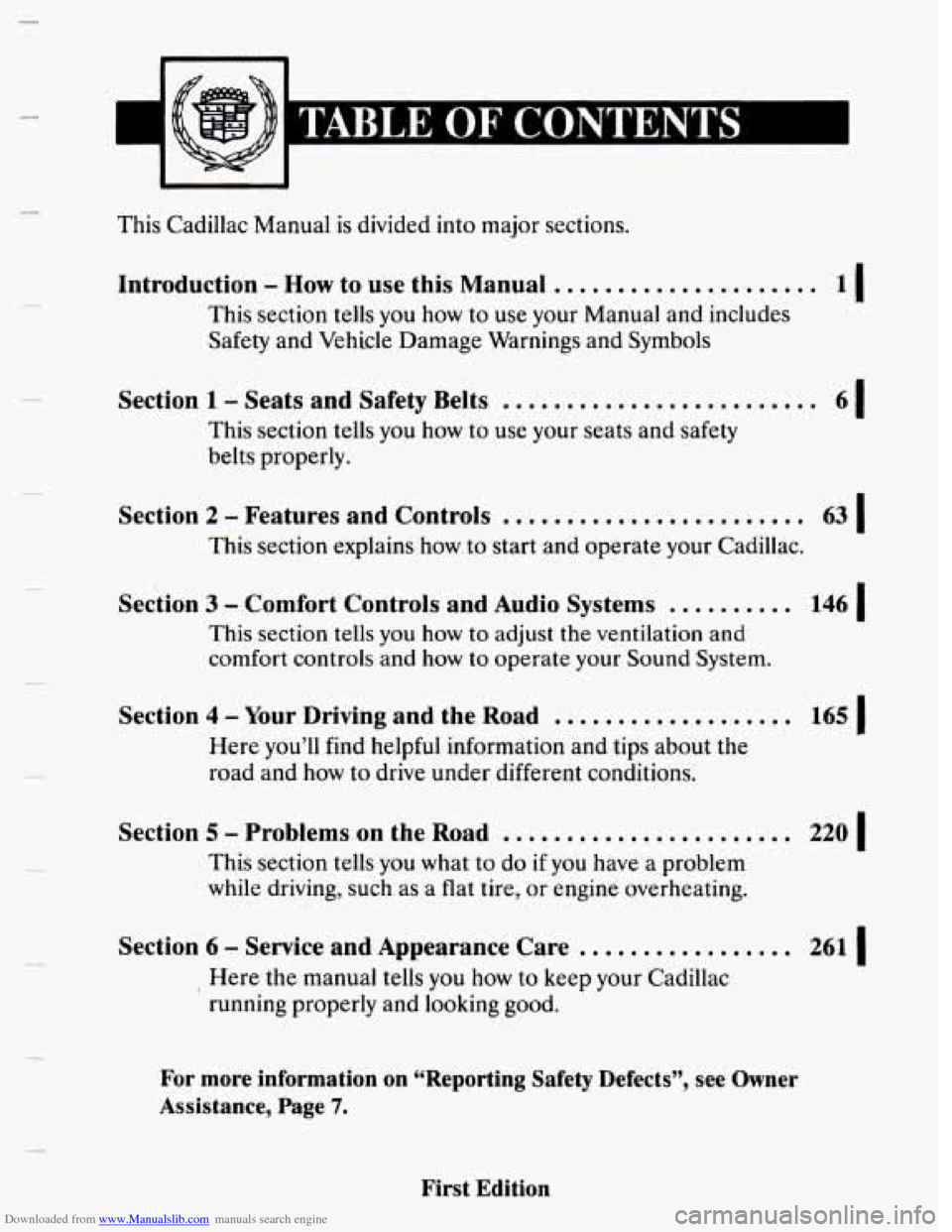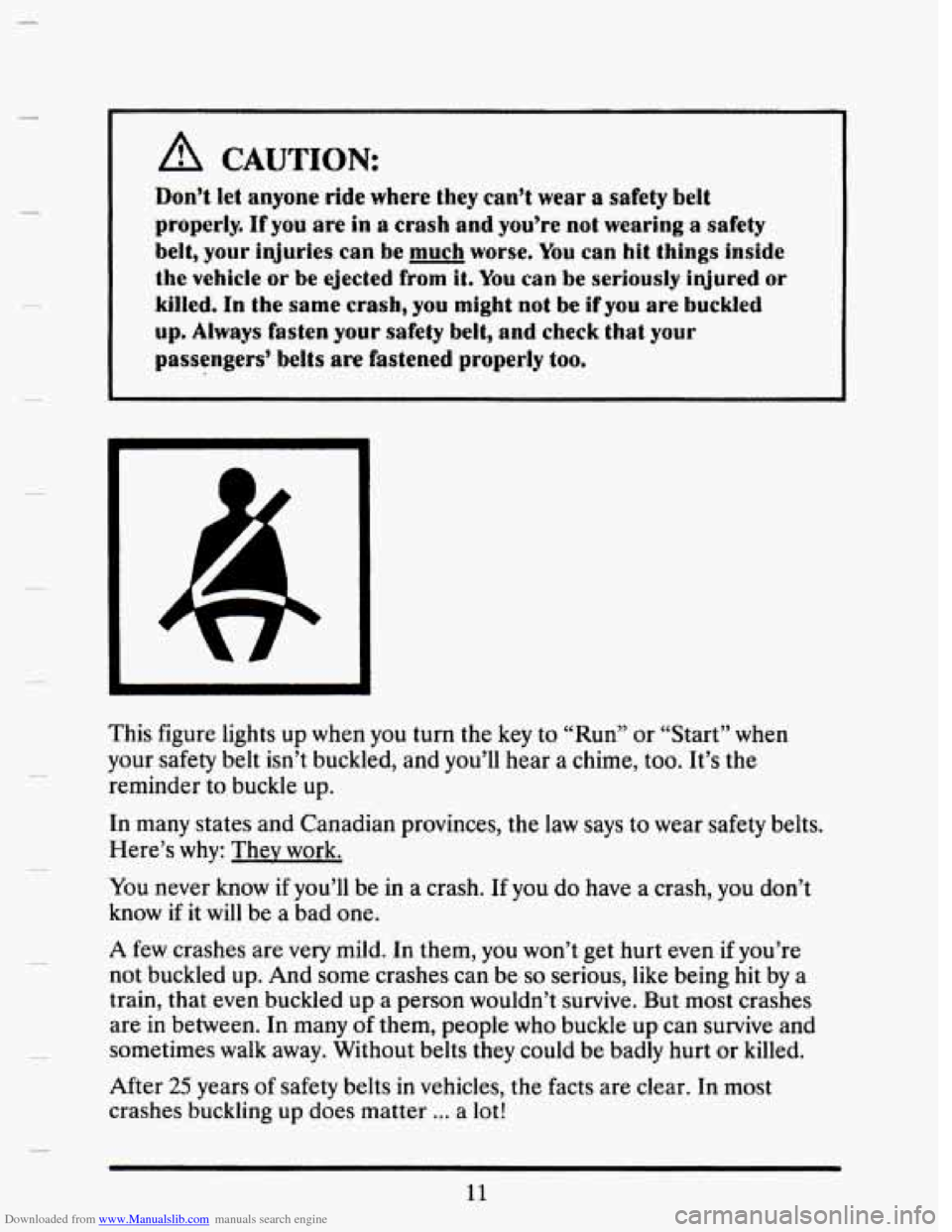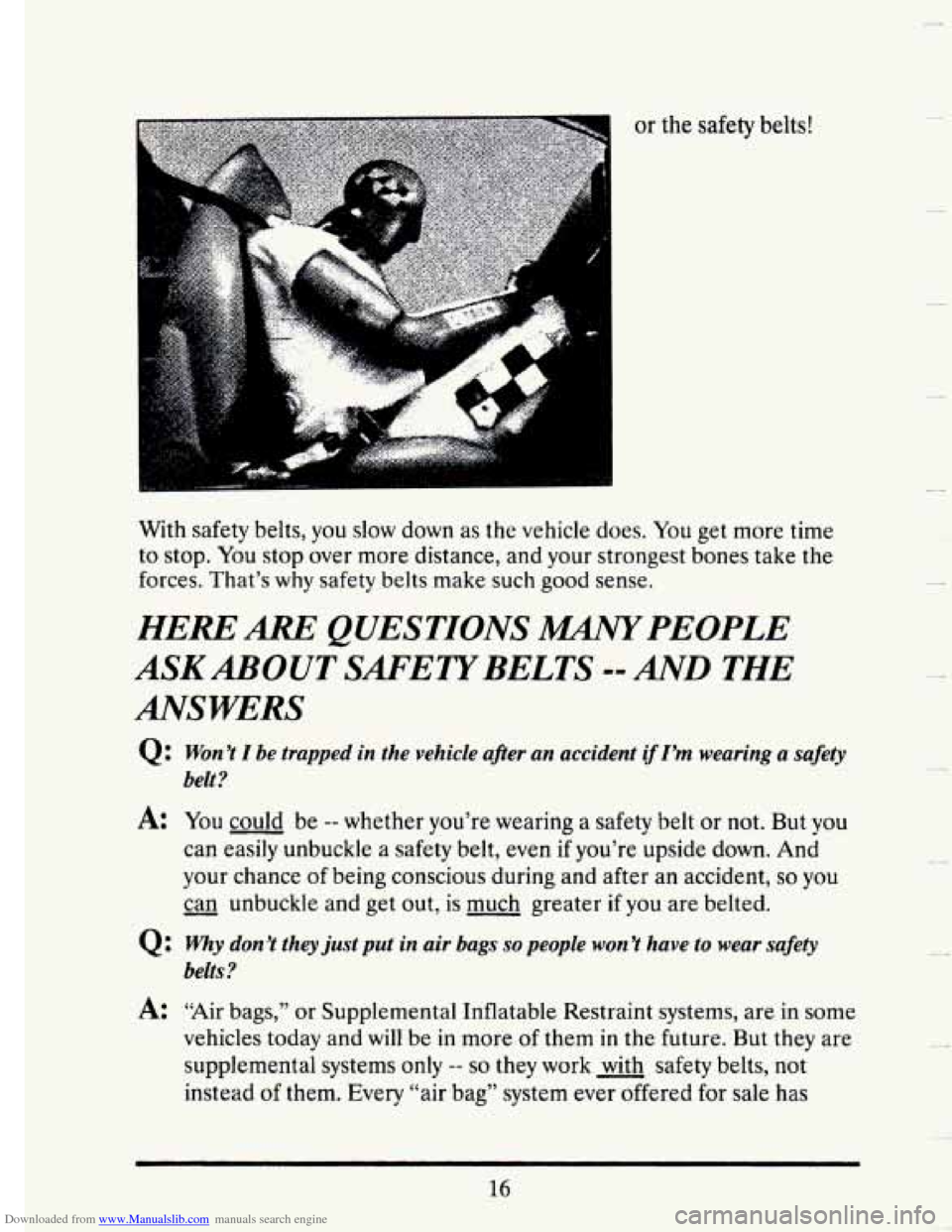Page 13 of 407

Downloaded from www.Manualslib.com manuals search engine This Cadillac Manual is divided into major sections.
Introduction - How to use this Manual .....................
This section tells you how to use your Manual and includes
Safety and Vehicle Damage Warnings and Symbols
11
Section 1 - Seats and Safety Belts .........................
This section tells you how to use your seats and safety
belts properly.
61
Section 2 - Features and Controls ........................
This section explains how. to start and operate your Cadillac.
63 I
Section 3 - Comfort Controls and Audio Systems .......... 146 I
This section tells you how to adjust the ventilation and
comfort controls
and how to operate your Sound System.
Section 4 - Your Driving and the Road ................... 165 I
Here you’ll find helpful information and tips about the
road and how
to drive under different conditions.
Section 5 - Problems on the Road ....................... 220 I
This section tells you what to do if you have a problem
while driving, such as a flat tire,
or engine overheating.
Section 6 - Service and Appearance Care ................. 261 I
Here the manual tells you how to keep your Cadillac
running properly and looking good.
For more information on “Reporting Safety Defects”, see Owner
Assistance,
Page 7.
First Edition
Page 17 of 407
Downloaded from www.Manualslib.com manuals search engine Ehicle Symbols
These are some of the symbols you will find on your vehicle. For example,
these
symbols are used on an original battery:
A
CAUTION
POSSIBLE INJURY
PROTECT EYES BY SHIELDING
8
AVOID SPARKS OR FLAMES COULD BA'TTERY
ACID
I
DOOR LOCK UNLOCK 1 FASTEN SEAT BELTS POWER
WINDOW I
3
Page 20 of 407
Downloaded from www.Manualslib.com manuals search engine SEATS AND SAFETY BELTS
Here you’ll find information about the seats in your Cadillac, your
Supplemental Inflatable Restraint (“air bag”) system and how
to use your
safety belts properly. You can also learn about some things you
should
- not do with safety belts.
SEATS AND SEAT CONTROLS
This section tells you about the seats -- how to adjust them, and also
about reclining front seatbacks, lumbar adjustments, heated seats, and
head restraints.
Power Seat Control
The power seat control switch is located on the outboard side of the seat
cushion.
The power control switch moves the seat foward and backward,
up and
down, and adjusts the angle
of the seat.
6
Page 22 of 407
Downloaded from www.Manualslib.com manuals search engine But don’t have a seatback reclined if your vehicle is moving.
A CAUTION:
Sitting in a reclined position when your vehicle is fn motion can
be dangerous. Even if you buckle up, your safety belts can’t do
their job when you’re redined like this.
r
The shoulder belt can’t do its job because it won’t be against
your body. Instead, it will be in front of you. In a crash you could
go into it, receiving neck or other injuries,
The lay belt can’t do its job either. In a crash the belt could go
up over pur abdomen. The belt forces would be there, not at
your pelvic bones. This could cause serious internal injuries.
For proper protection when the vehicle is in motion, have the
seatback upright. Then sit well back in the seat and wear your
safety belt properly.
8
Page 24 of 407
Downloaded from www.Manualslib.com manuals search engine higher temperature. To prevent uncomfortable overheating of the seats,
the heating elements are thermostatically regulated to automatica\
lly
maintain the temperature at the selected setting.
A telltale light in the
control switch reminds you that the heating system is in use. To preserve
the battery, the heated seats can only be used when
the ignition is turned
on, and are deactivated when the ignition is turned off.
Head Restraints
I
h
Slide the head restraint up or down so that the top of the restraint is
closest to the top of your ears.
This position reduces the chance
of a neck injury in a crash. The head
restraints tilt forward and rearward also.
SAFETYBELTS: THEY’RE FOR EKERYONE
This part of the manual tells you how to use safety belts properly. It also
tells you some things you should not do with safety
belts.
And it explains the Supplemental Inflatable Restraint, or “air bag”
system.
10
-.
Page 25 of 407

Downloaded from www.Manualslib.com manuals search engine c
A CAUTION:
Don’t let anyone ride where they cadt wear a safety beIt
properly. If you are in a crash and you’re not wearing a safety
belt, your injuries can be much worse, You can hit things inside
the vehicle or be ejected from it. You can be seriously injured or
killed. in the same crash, you might not be if you are buckled
up. Always fasten your safety belt, and check that your
passengers’ belts are fastened properly too.
This figure lights up when you turn the key to “Run” or “Start” when
your safety belt isn’t buckled, and you’ll hear a chime,
too. It’s the
reminder to buckle up.
In many states and Canadian provinces, the law
says to wear safety belts.
Here’s
why: They work.
You never know
if you’ll be in a crash. If you do have a crash, you don’t
know
if it will be a bad one.
A few crashes are very mild. In them, you won’t get hurt even if you’re
not buckled up. And some crashes can be
so serious, like being hit by a
train, that even buckled up a person wouldn’t survive.
But most crashes
are
in between. In many of them, people who buckle up can survive and
sometimes
walk away. Without belts they could be badly hurt or killed.
After
25 years of safety belts in vehicles, the facts are clear. In most
crashes buckling
up does matter ... a lot!
Page 26 of 407
Downloaded from www.Manualslib.com manuals search engine Why Safety Belts Work
When you ride in or on anything, you go as fast as it goes.
'f
For example, if the
bike is going 10 mph
(16 km/h), so is the
child.
12
Page 30 of 407

Downloaded from www.Manualslib.com manuals search engine or the safety belts!
.”
d
c
. ..
With safety belts, you slow down as the vehicle does. You get more time
to stop. You stop over more distance, and your strongest bones take the
forces. That’s
why safety belts make such good sense.
HERE ARE QUESTIONS lMANy PEOPLE
ANSWERS ASKABOUT
SAFETYBELTS
--AND THE
Q: Won’t I be trapped in the vehicle afler an accident if I’m wearing a safety
belt?
A: You could be -- whether you’re wearing a safety belt or not. But you
can easily unbuckle a safety belt, even if you’re upside down. And
your chance
of being conscious during and after an accident, so you
- can unbuckle and get out, is - much greater if you are belted.
Q t Why don’t they just put in air bags so people won’t have to wear safety
belts?
A: ‘Air bags,” or Supplemental Inflatable Restraint systems, are in some
vehicles today and
will be in more of them in the future. But they are
supplemental systems only
-- so they work with safety belts, not
instead
of them. Every “air bag” system ever offered for sale has
16